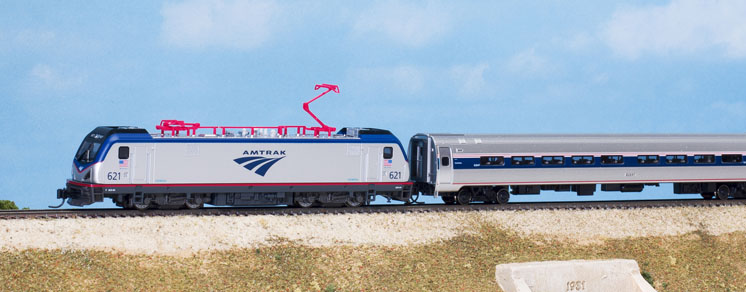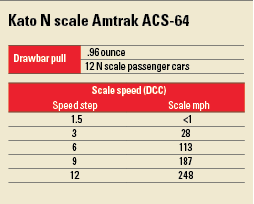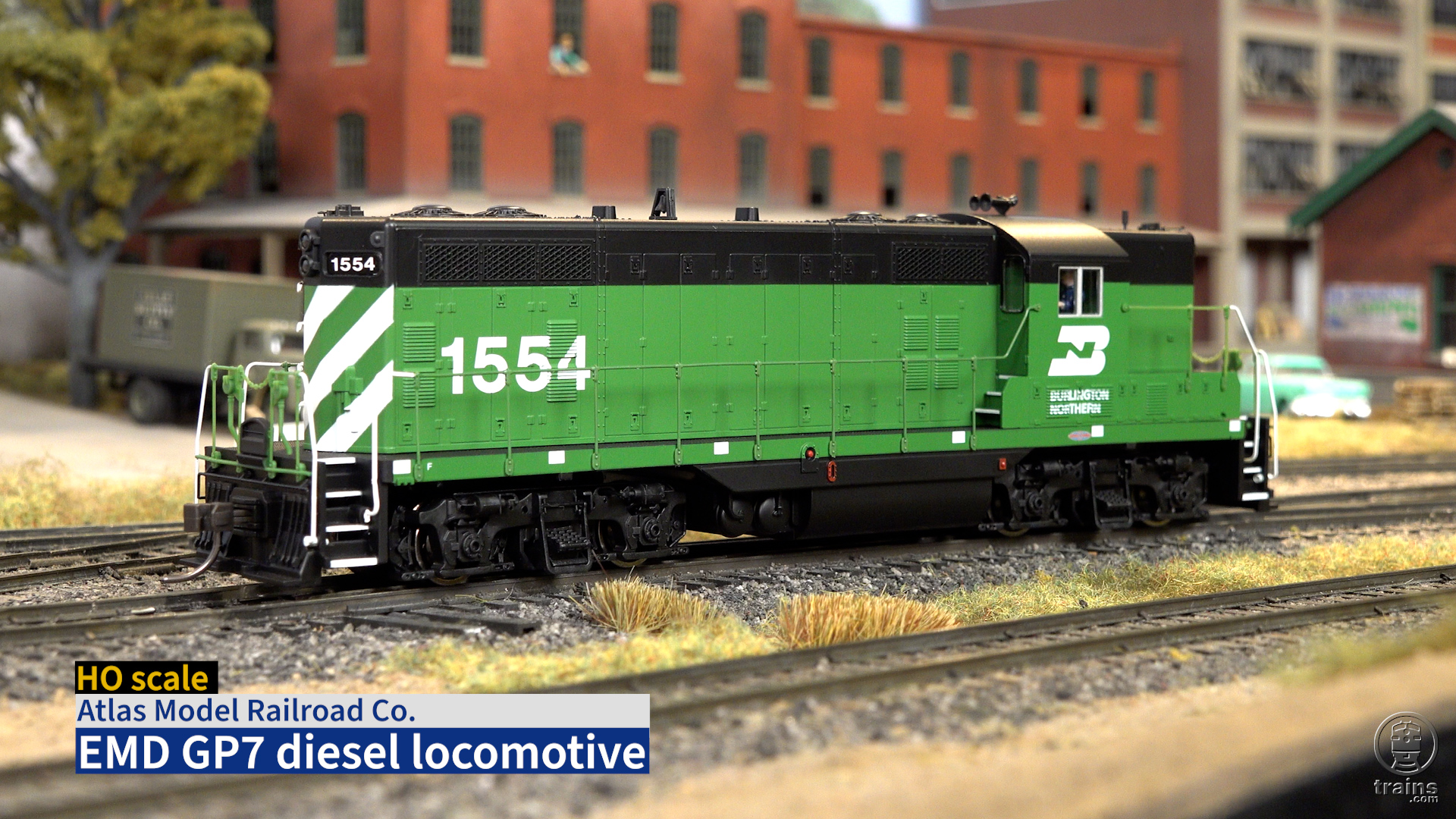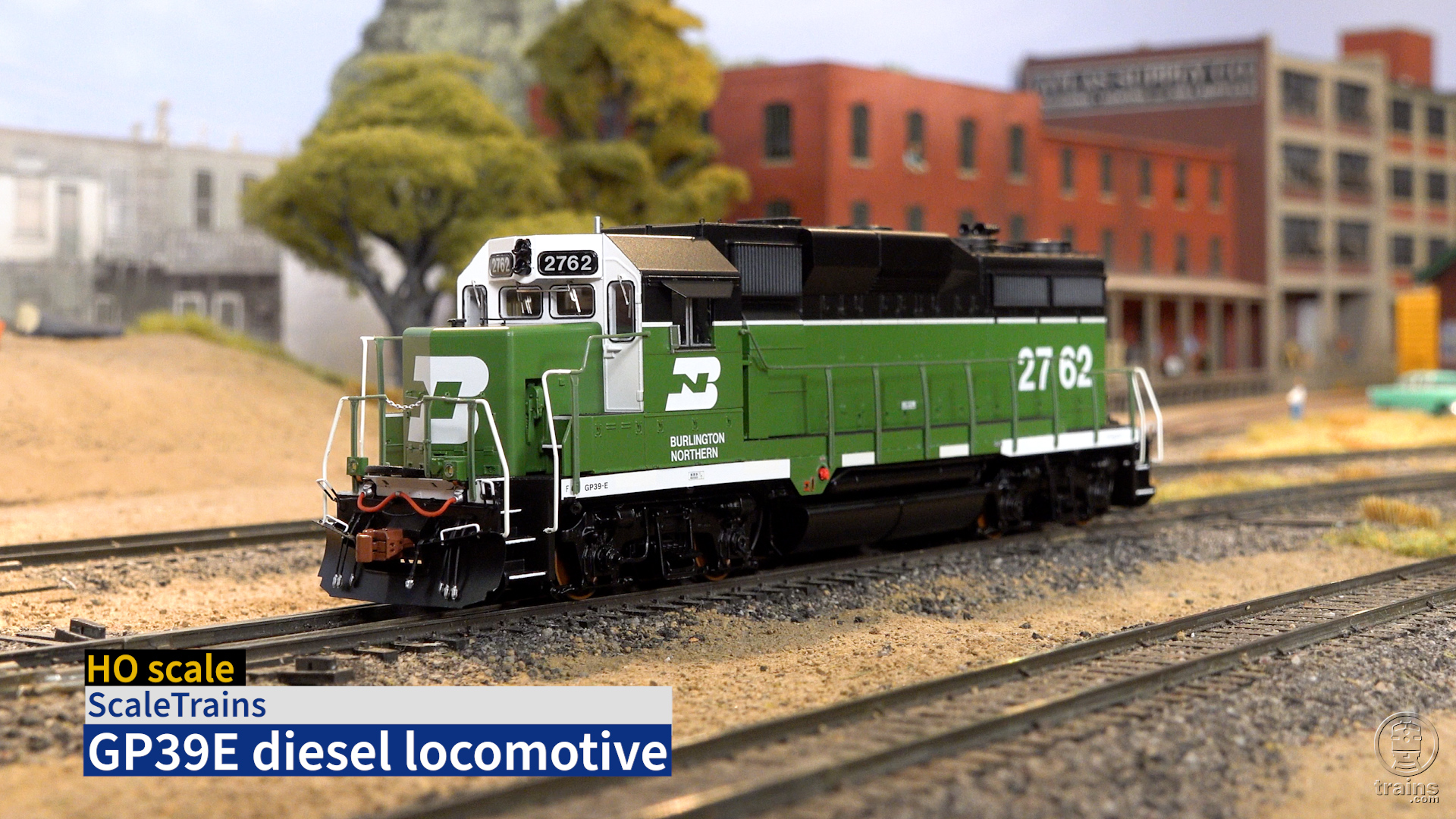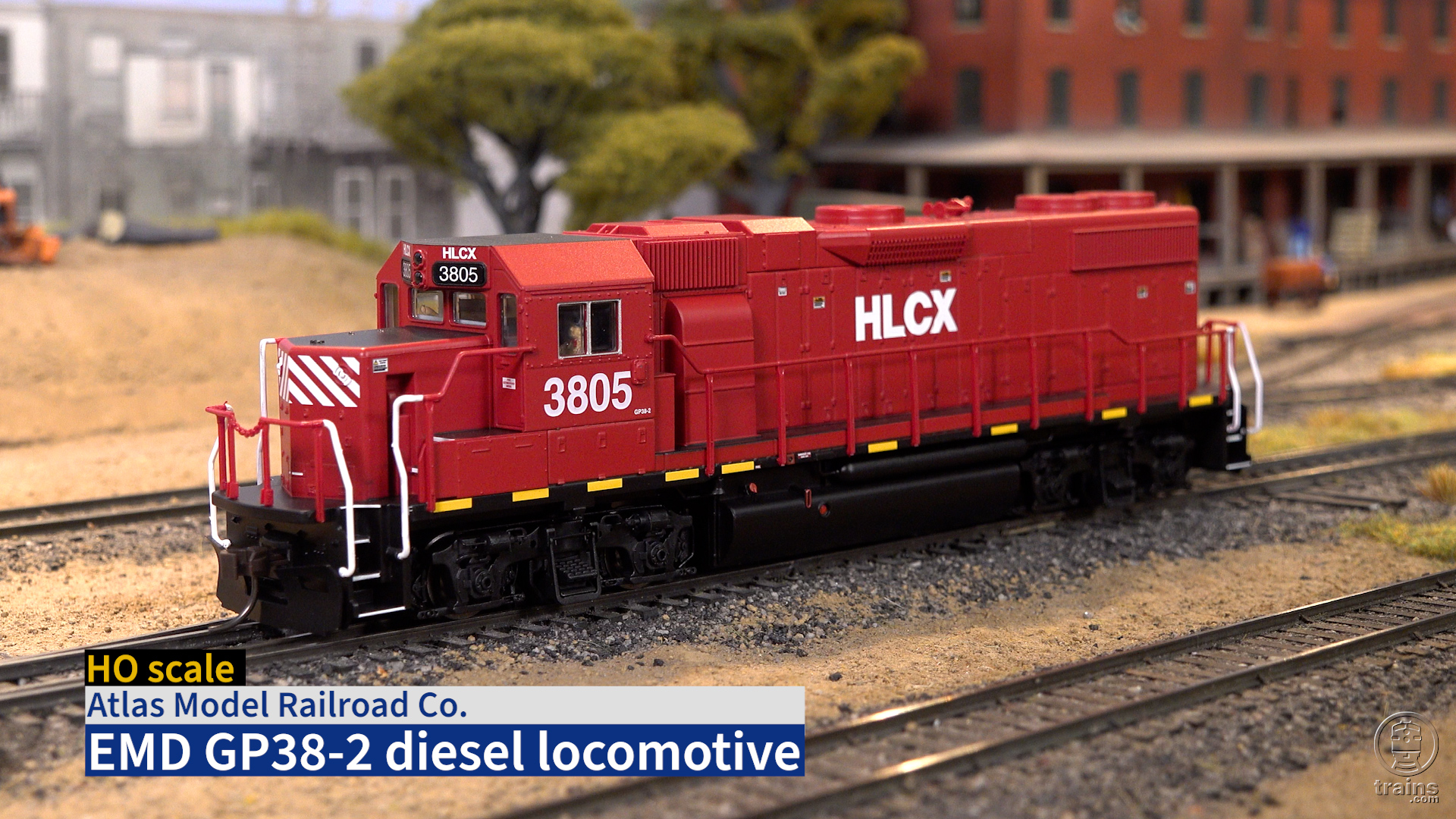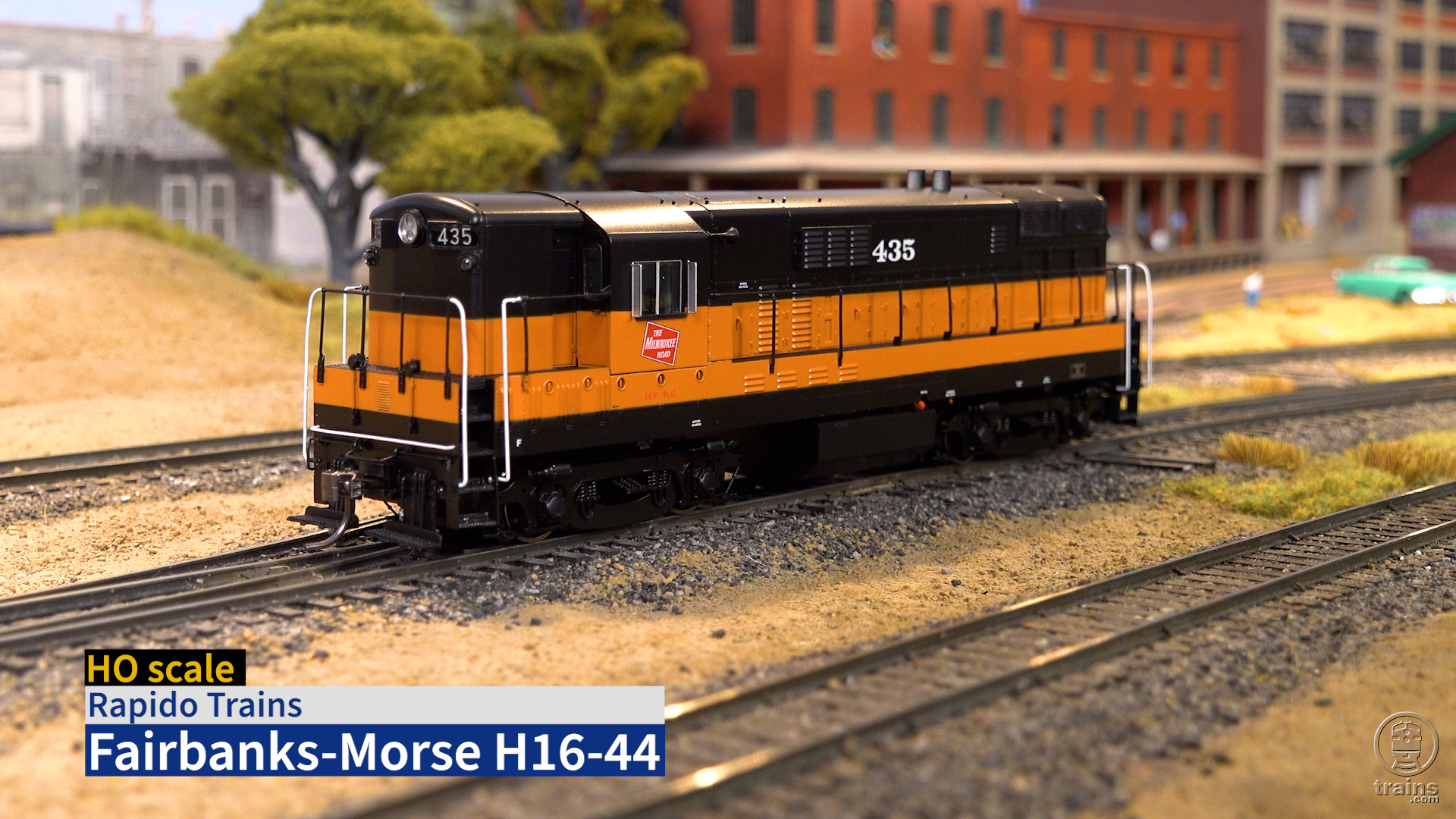The first prototype Cities Sprinter locomotives have been on Amtrak property for little more than two years, and now N scale modelers can get their hands on one from Kato. Also known as the ACS-64, these locomotives will pull all non-Acela trains on Amtrak’s electrified Northeast Corridor.
The prototype. The Cities Sprinter, or ACS-64, is an American-built, European-designed replacement for Amtrak’s 30-to-40-year-old AEM-7 and much younger, yet less reliable, HHP-8. The locomotives are based on Siemens’ successful four-axle Eurosprinter and Vectron electrics.
Modifications for North American use include improved crash protection for the engineer and the ability to run on Amtrak’s three alternating-current catenary power supplies.
The 64 in the name refers to the maximum power output of 6,400 kW, equivalent to 8,600 horsepower. This translates to a top cruising speed of 125 mph, with a flat-out capability for 135 mph. The locomotive was designed to accelerate 18-car trains of Amfleet equipment to 125 mph in about 8 minutes.
Included in Kato’s set, packaged in an attractive bookcase-style box, are four Amfleet I passenger cars: three coaches and a cafe car. The prototypes for these 85-foot-long cars were designed to replace the equipment Amtrak acquired from the railroads that opted out of passenger service at the debut of the National Railroad Passenger Corp. in 1971.
The cars were built by the Budd Co. with deliveries beginning in 1975. There are several seating configurations, but outwardly, there are two variations. The coaches have windows from end to end, while the food service cars have a blank portion in the center of the car.
The models. The ACS-64 matches most of the dimensions in a Siemens technical sheet I downloaded from the company website at www.siemens.com/mobility/locomotives. The overall length is about 2 scale feet long over the coupler pulling faces, but this is common on models, as the couplers are larger than exact scale. Also, Kato equipped the locomotive with long-shank, pivoting couplers to improve performance on tight model railroad curves.
Photos of these new locomotives show Kato did its homework. From rooftop to running gear, all the vents, conductors, insulators, resistor banks, and motion dampers are accounted for. The wheels even have the ventilated disk brake rotor detail of the full-size locomotive.
The conductors and insulators on the roof are brightly colored. These flexible plastic parts could benefit from some detail painting, which would help with the apparent chunkiness of the parts. The pantographs are made from the same plastic, which is forgiving of typical handling. Nubs on the pantograph arms keep these parts either stowed or raised, depending on the operator’s desires.
The locomotive paint is smooth and opaque, with sharp separations and clear lettering and numbering. The only lettering missing is the tiny instructions printed on the running gear and chassis parts. Detail painting would also add to the appearance of the underbody and truck detail. The cab side windows don’t include rearview mirrors.
The all-new Amfleet I cars share Kato’s attention to detail. The cars match dimensions published in the 1997 Car and Locomotive Cyclopedia (Simmons-Boardman). The so-called phase 6 paint scheme, also known as phase 4b, is evenly applied with sharp separations between the wide blue band and red and white pinstripes. An injection point in the center of the coach roof left a small mark.
Unlike the prototype, the couplers are truck-mounted. This means the end buffer detail is deleted. The trucks have wipers for picking up track power. Modelers can install the 11-211 – Interior Lighting Kit w/ LED Version 2. To gain interior access, spread the body sides above the trucks to release the catches and remove the floor. The interiors are molded in light tan plastic.
The cars weigh 1.1 ounce, .3 ounce lighter than the National Model Railroad Association recommended practice RP-20.1. The blackened metal wheels were all in gauge.
Under the shell. Slipping a thumbnail under the locomotive shell between the silver-painted body and the gray chassis, I was able to release the body casting from the underframe. A pair of die-cast metal weights encloses the flywheel-equipped motor.
A light board snaps into the top of the weights and conducts power to the motor. Surface-mounted light-emitting diodes illuminate the headlights and ditch lights at both ends through cast plastic light bars. A Train Control Systems K7D4 or Digitrax DN163K4A drop-in Digital Command Control decoder will fit this locomotive.
All wheels are powered through the universal shafts on the ends of the motor. One wheel on each truck has a traction tire. All other wheels pick up power.
On the test track. I used a Model Rectifier Corp. Tech4 MRC 200 power pack to test the direct-current performance of the locomotive. At 1.5V, the model started moving at a barely perceptible speed, much less than 1 scale mph. At 6V, the ACS-64 averaged 113 scale mph, and at 12V, it lived up to its Sprinter name, posting a 248 scale mph average, much faster than the prototype.
The locomotive’s .96 ounce of drawbar pull is equivalent to 12 N scale passenger cars on straight and level track.
I ran the ACS-64 and Amfleet I passenger car set on Model Railroader’s 2015 project layout, the N scale Red Oak.
Although the models had no trouble with the layout’s 13″ radius minimum curves, the long overhang of the locomotive meant it just barely cleared the plate girder bridge sides on the span over the highway on the layout.
I also tested the models on several pieces of 11″ radius Atlas track. The locomotive and cars had no trouble negotiating the curve, including an S curve, going either forward or backward. The long-shank couplers on the locomotive and the truck-mounted couplers on the passenger cars worked well together to allow operation on the tighter curves.
Kato has another finely detailed, smooth-running locomotive in the ACS-64. The new Amfleet I cars are perfect for the high-density service offered on Amtrak’s Northeast and Keystone corridors. The appearance and performance of these models make them hard to resist.
Price: $250; Amfleet I Phase 6 two-car set A with two coaches or Amfleet I Phase 6 two-car set B with coach and cafe car, $55 each.
Manufacturer
Kato USA Inc.
100 Remington Road
Schaumburg, IL 60173
www.katousa.com
Era: Feb. 2, 2014, to present, locomotive; 2003 to present, rolling stock
Roadname: Amtrak Phase 6, locomotive and rolling stock
Features (locomotive)
▪▪Positionable pantographs
▪▪Directional headlights
▪▪Traction tire-equipped
▪▪Flywheel-equipped motor
▪▪Geared to match speed of Kato GE P42
▪▪Weight: 3.6 ounces





